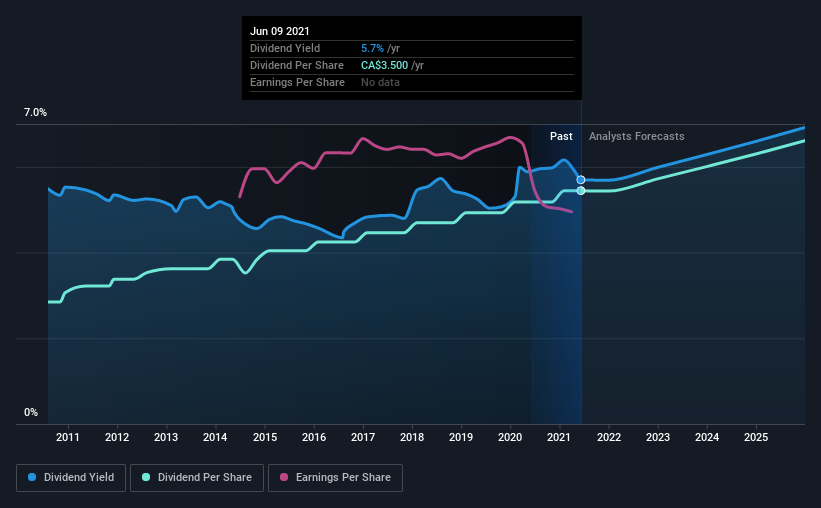We Wouldn't Be Too Quick To Buy BCE Inc. (TSE:BCE) Before It Goes Ex-Dividend
BCE Inc. (TSE:BCE) is about to trade ex-dividend in the next four days. The ex-dividend date is usually set to be one business day before the record date which is the cut-off date on which you must be present on the company's books as a shareholder in order to receive the dividend. The ex-dividend date is important because any transaction on a stock needs to have been settled before the record date in order to be eligible for a dividend. In other words, investors can purchase BCE's shares before the 14th of June in order to be eligible for the dividend, which will be paid on the 15th of July.
The company's next dividend payment will be CA$0.88 per share. Last year, in total, the company distributed CA$3.50 to shareholders. Last year's total dividend payments show that BCE has a trailing yield of 5.7% on the current share price of CA$61.42. If you buy this business for its dividend, you should have an idea of whether BCE's dividend is reliable and sustainable. We need to see whether the dividend is covered by earnings and if it's growing.
See our latest analysis for BCE
Dividends are typically paid from company earnings. If a company pays more in dividends than it earned in profit, then the dividend could be unsustainable. BCE distributed an unsustainably high 136% of its profit as dividends to shareholders last year. Without extenuating circumstances, we'd consider the dividend at risk of a cut. A useful secondary check can be to evaluate whether BCE generated enough free cash flow to afford its dividend. It paid out 83% of its free cash flow as dividends, which is within usual limits but will limit the company's ability to lift the dividend if there's no growth.
It's disappointing to see that the dividend was not covered by profits, but cash is more important from a dividend sustainability perspective, and BCE fortunately did generate enough cash to fund its dividend. If executives were to continue paying more in dividends than the company reported in profits, we'd view this as a warning sign. Very few companies are able to sustainably pay dividends larger than their reported earnings.
Click here to see the company's payout ratio, plus analyst estimates of its future dividends.
Have Earnings And Dividends Been Growing?
Businesses with shrinking earnings are tricky from a dividend perspective. Investors love dividends, so if earnings fall and the dividend is reduced, expect a stock to be sold off heavily at the same time. So we're not too excited that BCE's earnings are down 3.7% a year over the past five years.
Another key way to measure a company's dividend prospects is by measuring its historical rate of dividend growth. Since the start of our data, 10 years ago, BCE has lifted its dividend by approximately 6.7% a year on average. That's intriguing, but the combination of growing dividends despite declining earnings can typically only be achieved by paying out a larger percentage of profits. BCE is already paying out a high percentage of its income, so without earnings growth, we're doubtful of whether this dividend will grow much in the future.
Final Takeaway
From a dividend perspective, should investors buy or avoid BCE? Earnings per share have been in decline, which is not encouraging. Worse, BCE's paying out a majority of its earnings and more than half its free cash flow. Positive cash flows are good news but it's not a good combination. With the way things are shaping up from a dividend perspective, we'd be inclined to steer clear of BCE.
Having said that, if you're looking at this stock without much concern for the dividend, you should still be familiar of the risks involved with BCE. Be aware that BCE is showing 4 warning signs in our investment analysis, and 1 of those doesn't sit too well with us...
If you're in the market for dividend stocks, we recommend checking our list of top dividend stocks with a greater than 2% yield and an upcoming dividend.
This article by Simply Wall St is general in nature. It does not constitute a recommendation to buy or sell any stock, and does not take account of your objectives, or your financial situation. We aim to bring you long-term focused analysis driven by fundamental data. Note that our analysis may not factor in the latest price-sensitive company announcements or qualitative material. Simply Wall St has no position in any stocks mentioned.
Have feedback on this article? Concerned about the content? Get in touch with us directly. Alternatively, email editorial-team (at) simplywallst.com.

 Yahoo Finance
Yahoo Finance 
